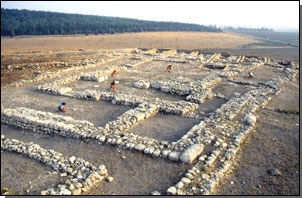1994-1998 Excavation Results

Area F
The lower mound is being properly excavated for the first time, revealing a massive Middle Bronze Age fortification system and a Late Bronze Age public edifice. Overlying this is an Iron Age stratum, possibly from the 10th century BCE (Low Chronology). In 2000 we will continue to excavate the Middle Bronze and Late Bronze remains.
Area H
The kings of Assyria constructed massive palaces on the mound. Reexamination of these structures has thrown new light on Megiddo’s role as an Assyrian provincial center. Below these remains, we have uncovered new evidence about the last days of Israelite Megiddo, on the eve of Assyrian conquest and its destruction by Tiglath-Pileser III King of Assyria (732 BCE). In 2000, we plan to expose the remains of biblical Israel in its prime, the 10th and 9th centuries BCE. Far, far below, an unexcavated segment of the Late Bronze Age palace continues to beckon, but it will require many years to penetrate down to the level at which it is found.
Area J
Area J contains the most elaborate sequence of temples ever found in the Levant, from the Early Bronze I (4th millennium BCE) to the end of the Late Bronze Age (12th century BCE). In 1994, the Expedition clarified the history of the earliest temple (Early Bronze IB). In 1996 and 1998, we discovered an unparalleled monumental compound of the later phase of Early Bronze IB (3300-3100 BCE). It consists of several long, parallel stone walls, each of which is 4 meters wide. Between the walls were narrow corridors, filled hip-deep with the remains of animal sacrifice. These walls lie immediately below the huge ‘megaron’ temples of the Early Bronze III (2700-2300 BCE).
Area K
Remains of Stratum VA-IVB have been exposed. Beneath them lies Stratum VIA. Both strata were destroyed by fire. Which is the Solomonic city of Megiddo? The resolution of this question will determine the course of scholarly synthesis of archaeology with Israelite history and of the chronology of the Iron Age, the biblical era. In 2000 we will continue to excavate down to the Iron I and Late Bronze Levels.
Area L
An imposing ashlar building on the northern edge of the mound was explored by Yigael Yadin, and identified with Stratum VA-IVB, widely regarded as the Solomonic City. The architectural plan of this building, labeled by Yadin “Palace 6000” resembles that of Syrian palaces of the same period. Is this, as has commonly been thought, a Solomonic structure? Or does it stem from a later period in the Israelite monarchy?
The excavation of this area in 1998 revealed three levels: the upper, close to the surface, included remains of open courtyards paved with pebbles, which date to the Stratum III (The Assyrian Period). The main feature of the second level is the set of “stables” – similar to the buildings excavated in the past a bit to the south and in the southwestern sector of the tell. Each unit is built of three longitudinal halls, separated by a row of mangers and stone pillars. The side halls are paved with pebbles and the central aisle is paved with thick plaster. There is an on-going debate about the function of these buildings – stables, storehouses, barracks, or market places. We took earth samples from the floors in order to identify animal waste. Under this level we uncovered the remains of the ashlar Palace 6000, which was first investigated by Yadin in the 1960’s.
Area M
Here we began cleaning and re-investigating areas excavated by Gottlieb Schumacher on behalf of the German Society for Palestinian Research at the beginning of the 20th century. In 1998 we excavated four squares near the large, beautifully stone-built tomb excavated by Schumacher. Unique in this country, it is probably the tomb of one of the monarchs of Megiddo in the second millennium BCE. We were able to date the tomb to the later phase of the Late Bronze Age and to redate some of the elements in this area to the Late Bronze Age, rather than to the Middle Bronze Age, as previously suggested.




